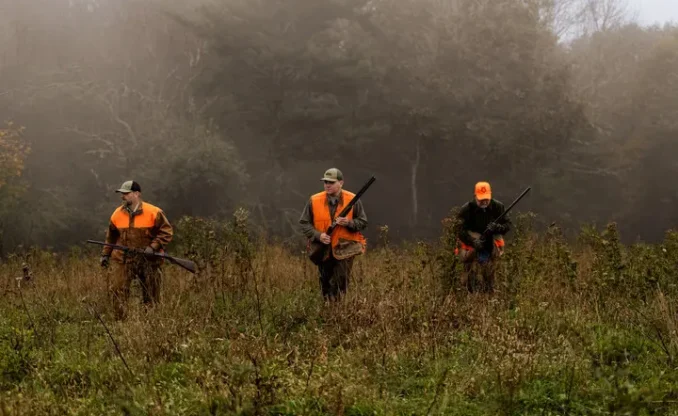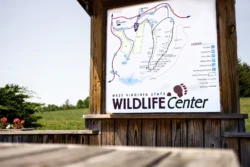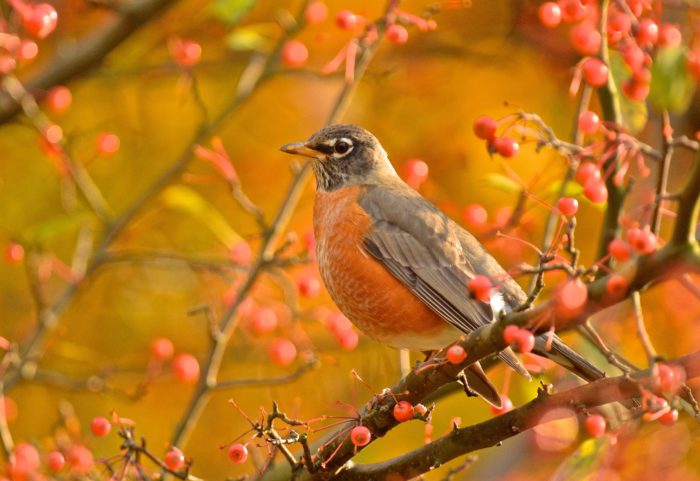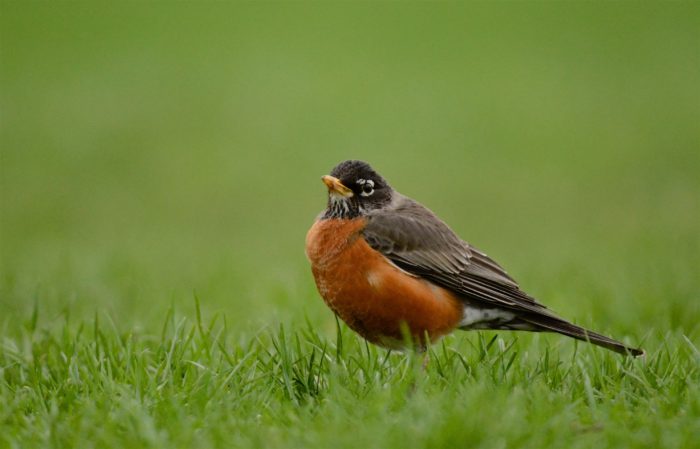American Robin Overview
Even though the American robin is the Mountain State’s best-known harbinger of spring, it is probably safe to assume that most of us really know very little about this cheerful songbird. First, it may surprise you to find out that our robin is not really a robin at all, but a member of the thrush family. It is a close cousin to the bluebird, wood thrush and veery. The real robin redbreast is a native of the old world. This English songbird is much smaller than our robin and has a bright reddish-orange throat and breast. But the American robin, whose breast may be a light brown to a rich, dark, brick red color, still reminded our forefathers of the one found in England, so they named it in remembrance of their homeland.
Robins are familiar birds throughout the United States and are the state birds of Connecticut, Michigan and Wisconsin. They nest from the limit of trees in northern North America south to southern California and across to southern Georgia. Although the majority of robin’s winter in warmer climates, they also regularly winter in northern climes, particularly during mild winters. Here they will roost among evergreens, feeding on persistent winter berries such as sumac, greenbrier and bittersweet. On warm winter days or during a thaw, they can be seen searching the ground for insects. The sighting of robins on such days leads many to think that an early spring is on the way.
However, it is not until late February or early March that the real northward migration begins. By mid-March, robins are a common sight in West Virginia and on warm spring-like mornings they can be heard singing their cheerful songs. In just a short time courtship will begin in earnest. At this time male robins can be seen chasing one another around, apparently trying to establish and defend territories. Many people have also experienced repeated attacks by male robins pecking at their windows or other shiny, polished surfaces. These robins are not crazy, but think their reflected image is another bird vying for their nesting territories.
Robins may build nests anywhere from the ground to the treetops, but usually in a place which provides firm support and where the nest is sheltered from the rain. Common locations include forks of evergreens (usually early nests), deciduous trees and shrubs, and many man-made sites such as building ledges, windowsills, porch gables, or atop outside lights. Females usually do the nest building, without much help from the males, using coarse grasses, twigs, weed and grass stems and occasionally string, rags, or other debris. It is rather a bulky, untidy structure on the outside, but the inside is a neat deep cup lined with smooth mud and soft grasses. During construction, the female uses her bill and feet at the same time to weave the nest, while smoothing and shaping the mud lining with her breast.
The nesting season begins in April, and two and sometimes three broods are raised. From three to six, but usually four, unmarked pastel blue eggs are laid. The female then incubates her eggs for about two weeks. Both parents tend the nestlings who are ready to leave the nest in about 14 or 16 days. Unlike their parents, their breasts are spotted, revealing the “thrush” in their lineage. At this time the young birds are very vulnerable to predators, including cats and dogs, and when the nests are over water (as they frequently are), to turtles, large fish and frogs. While able to fly to the ground, often they are not yet strong enough to fly back up to safer perches.
Young birds eat mainly insects, as do the young of most birds. The parents can be seen hopping about lawns and meadows in search of beetles, weevils, ants, grasshoppers, and, particularly, earthworms and grubs. Contrary to what observers have often believed, robins locate earthworms by sight, not by sound, even though the birds cock their heads in a manner that resembles intense listening.
When the last brood of the summer has been reared, robins change their habits and haunts. Their cheerful songs are rarely heard now, and they begin to assemble into flocks searching for wild fruits. Robins are thus important distributors and planters of many of our wild fruits. At this time, they start to congregate and roost at night. By August, birds in these roosts may number in the thousands as they prepare for their southward migrations.
In the Mountain State, however, these large flocks are rather rare, and the fall migration is somewhat inconspicuous. They disappear quietly from our yards and orchards, going into the deeper, more remote woods. In October they begin to move southward, although many remain in the state. By late October and early November, these birds will join migrants from the north, and large concentrations of robins can be seen flying along the mountain ridges.
Where robins are seen in the state during the winter months, they may be enticed to feeding stations with breadcrumbs or cottage cheese. To tide robins over during especially bad winter storms, many people offer elderberries or wild grapes that they have collected for this purpose in the fall. In years of particularly harsh winter weather, many will not survive. But their adaptability, particularly to the changes brought about by man’s activities, insures their survival as a species. Spring in the Mountain State wouldn’t be the same without these cheerful songbirds.





